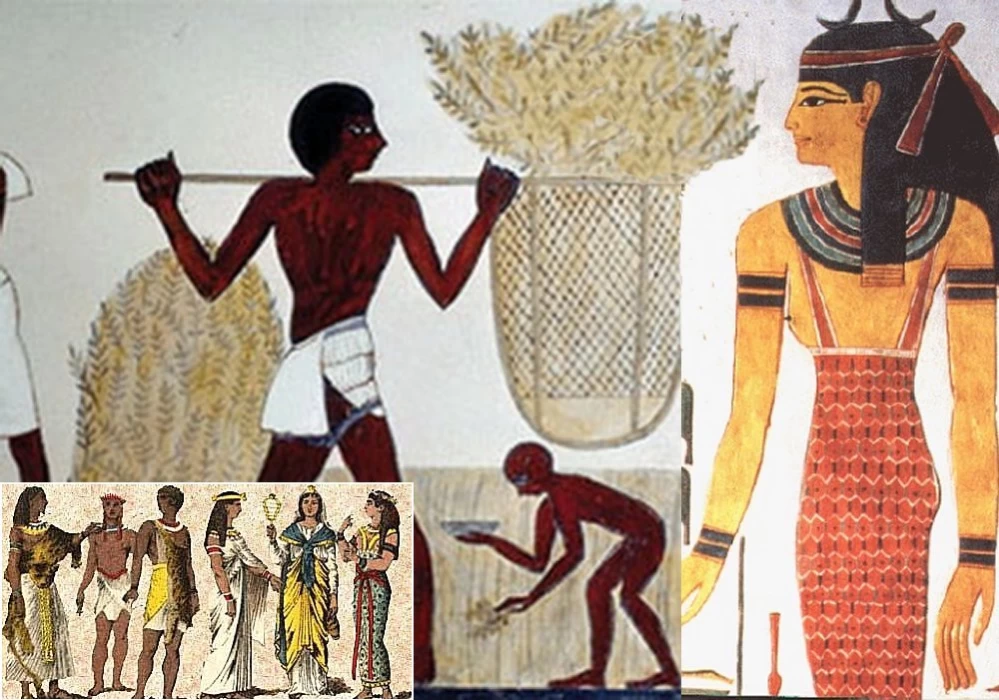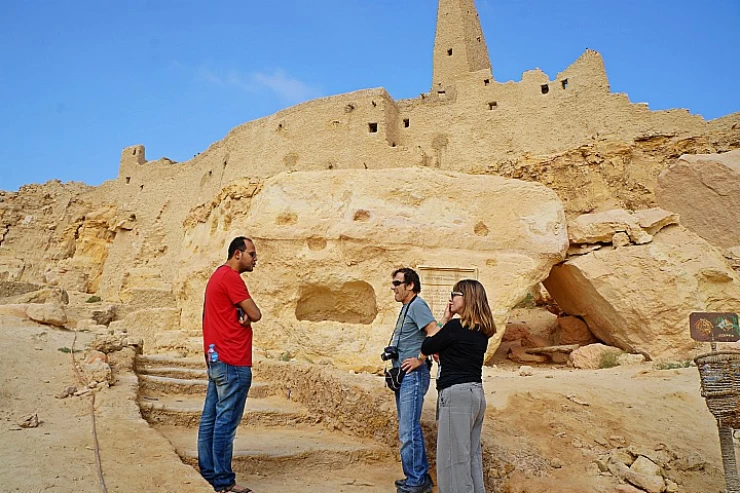
Costumes in Ancient Egypt
Clothing and Fashion in Ancient Egypt
Fashion in Ancient Egypt encompasses the garments worn by the Egyptians from the conclusion of the Neolithic period (circa 3100 B.C.) until the fall of the Ptolemaic Kingdom with the demise of Queen Cleopatra around 30 B.C. The clothing of this era was characterized by a rich array of colors and fabrics, often embellished with precious stones and jewelry. The attire of the ancient Egyptians was crafted not only for aesthetic appeal but also for comfort, designed to maintain a cool body temperature in the sweltering desert climate. Linen emerged as the predominant fabric in Ancient Egyptian clothing, favored for its ability to provide relief from the subtropical heat. This fabric is derived from the flax plant, with its fibers spun from the plant's stem. The processes of spinning, weaving, and sewing were integral to Egyptian society. While vegetable dyes could be applied to textiles, most garments were typically left in their natural hue. Although wool was recognized, it was deemed impure, and only the affluent could afford garments made from animal fibers, which were often subject to cultural taboos. Wool was occasionally utilized for women's outerwear but was prohibited in temples and sacred sites.
Individuals of lower social standing, including workers and peasants, consistently donned Shinta, a garment crafted from linen, which was common among the populace. Slaves frequently labored without clothing. The predominant headgear was known as khat or herbal, a striped fabric typically worn by men. During the era of the Pyramids, or the Old Kingdom, which began around 2130 B.C., clothing was quite basic. Men typically wore skirts called Shendyt, which were secured at the waist and could be styled in various ways, including being folded or gathered at the front. These skirts were relatively short during this period. In the subsequent Middle Kingdom era, around 1600 B.C., the length of the skirts increased. By approximately 1420 B.C., garments such as light jackets or long-sleeved blouses, along with longer dresses for women, became prevalent. Throughout the Old, Middle, and New Kingdom periods, ancient Egyptian women primarily wore a simple garment known as Kalasiris. Women's attire in ancient Egypt was generally more modest compared to that of men, with dresses typically secured by one or two straps and reaching the ankle. The upper portion of the dress could be adjusted to sit at the bust, and the length of the garment often signified the wearer's social status. Women adorned their dresses with beads or feathers for decorative purposes and often opted for shawls, capes, or robes. The shawl, made of fine linen, measured approximately 4 feet in width and 13 or 14 feet in length, and was usually worn in a pleated style.
In ancient Egypt, children remained unclothed until they reached the age of six. Upon turning six, they were permitted to don garments to shield themselves from the arid climate. A prevalent hairstyle among these children was the side-lock, characterized by a length of unshorn hair on the right side of the head. Despite their lack of clothing, children adorned themselves with jewelry, including anklets, bracelets, collars, and hair ornaments. As they matured, they adopted the same styles as their parents. In the realm of ancient Egyptian fashion, wigs held significant importance, particularly among the kings, rulers, and affluent individuals of both genders. These wigs were crafted using various methods, sometimes incorporating human hair and at other times enhanced with fibers from date palms. They were often styled in tight curls and narrow braids. Worn by both men and women during special events, these wigs were frequently topped with cones of scented fat, which melted to release fragrant aromas of perfume and hair products.
Jewelry held significant popularity in ancient Egypt, transcending social classes, whether among the affluent or the impoverished. Typically, these adornments were substantial and somewhat cumbersome. The primary purpose of wearing jewelry was its aesthetic appeal, complementing the simple, white linen garments favored by the ancient Egyptians. They exhibited a strong preference for vibrant colors, lustrous stones, and precious metals, as exemplified by the exquisite artifacts of King Tutankhamun displayed in the Egyptian Museum in Cairo. These masterpieces were crafted from locally sourced materials, including gold mined from Egypt's eastern desert and from Nubia, which was an Egyptian territory for many centuries. Conversely, silver was a rare commodity, imported from Asia, and was often regarded as more valuable than gold. The eastern desert also served as a vital source for colorful semi-precious stones such as carnelian, amethyst, and jasper. Turquoise was mined in the Sinai Peninsula, while the deep blue lapis lazuli was sourced from distant Afghanistan. Additionally, glass and faience—glazed materials made from a core of stone or sand—were popular alternatives to natural stones due to their availability in various colors. The ancient Egyptians demonstrated remarkable craftsmanship in creating jewelry from turquoise and metals like gold and silver, as well as small beads. Both men and women adorned themselves with brightly colored earrings, necklaces, and other ornaments. Those unable to afford gold or precious stones often resorted to crafting jewelry from colored pottery beads, which were also artistically shaped.
The practice of embalming facilitated the advancement of cosmetics and perfumes. Ancient Egypt was renowned for its extensive and highly sought-after perfumes, which were among the most expensive in antiquity. The Egyptians were the most prolific users of makeup compared to other ancient civilizations. They adorned their nails and hands with henna. Numerous artifacts related to the preservation of cosmetics can be found in the Egyptian Museum, particularly within the renowned collection of King Tutankhamun, which visitors can view during standard tours of the museum. Black eyeliner, derived from Galena, was utilized to accentuate and define the eyes, while eye shadow was crafted from crushed malachite. The red pigment used for lips, traditionally associated with women, was sourced from ochre. These cosmetic products were often mixed with animal fats to enhance their consistency and longevity. Both men and women applied Galena or powdered malachite not only for aesthetic purposes but also due to the belief that it served to protect their eyes from dust and dirt. Research published by the American Chemical Society in the Journal of Analytical Chemistry revealed that the inclusion of lead in these cosmetics was intentional. The findings suggest that lead, in conjunction with naturally occurring body salts, produces nitric oxide, which is known to bolster the immune system. It is posited that the ancient Egyptians deliberately engineered these products to enhance immunity, potentially aiding in the prevention of eye infections.
The footwear of that period was characterized by both functionality and elegance, distinguishing between various types such as public shoes, military footwear, children's shoes—which were essentially smaller replicas of adult styles—and the regal shoes worn by royalty. Footwear was largely unisex, comprising leather sandals or, for the priestly class, those made from papyrus. Given that Egyptians typically went barefoot, sandals were primarily reserved for special occasions or situations where foot protection was necessary.
A Brief Analysis of Policy, Cultural, and Historical MilieusThe costumes of ancient Egypt carry an immense weight in comprehending the social, cultural, and religious relations of one of the most complex civilizations in the world. Clothing played an essential role in the lives of the ancient Egyptians; it was not worn solely to cover the body. Rather, it signified social class, sex, occupation, and religion, all of which were in harmony with the surroundings and the sophisticated civilization that the people of the Nile River developed.
Linen is the Fabric of Choice in the ancient Egyptian clothes.
In ancient Egypt, one of the most popular and numerous textiles was the flax linen, which was predominantly cultivated along the banks of the Nile. The high temperatures in Egypt made it unavoidable to wear light and porous materials; hence, linen became the most appropriate material to use. All the same, the process of making linen from the flax plant was rather labor-intensive because it involved soaking the plant, pounding it down to retrieve fewer strands of it, and finally, yarn coming from those strands.
Zibellina esdromis fine-quality linen was especially popular with the nobles’ elite. The most advanced, termed "palace linen," was quite light but stable, glossy, and a bit transparent, indicating that it was designed for the affluent class. Nobility and priests, including the pharaohs, wore the most delicate and immaculate white linen attires, which were also for royalty due to their unblemished look and spiritual aspect, while the lower class dressed in the most tattered and coarse fabrics.
The clothing worn by the elite reflected their position, riches, and belief in their godliness. As earthly gods, the Queen and Pharaoh donned fashionable elements of clothing infused with various images. One of the most popular items of clothing worn by the pharaoh was the'shendyt’, a tailored pleated skirt that was extended with both gold and gem decorations. It was held in place by a decorative sash and, at times, was worn with a beautifully crafted robe or jacket for events.
Pharaohs also had a piece of headgear that was almost a statue of a king, called the ‘names’, which is a striped fabric wrapped around the head and tied at the back. All three, together with the false beard, the headdress of a king, and crowns with either the white or red crown of Egypt or the double crowns of Egypt—a sign of authority and power, only that it was royal power.
They wore clothes similar to those of the pharaoh but not as ostentatious. Richer men and women wore complex necklaces that included gold and colored stones. Their dresses were elaborately designed to exhibit their social class, with women frequently dressing in body-hugging sheaths made out of quality linen.
As the elites displayed their opulent clothing, the vast majority of the Egyptian population, consisting of farmers, laborers, artisans, and servants, put on simpler clothes. Working-class men were mostly found dressed in a simple loincloth or a knee-length coarser linen kilt. The tunic dresses worn by women were no exception and were specially designed to facilitate a woman's domestic and daily activities.
In spite of having simple clothing, it was clear that they took time and effort in the way they looked. The cleanliness and general appearance of the Egyptians of all social classes were important, and this can be attributed to the fact that they applied perfumes, oils, and cosmetics on a daily basis as part of their dressing code.
Religious and ceremonial costumes
Religious beliefs and practices permeated every aspect of daily life in ancient Egypt; hence, the costumes worn during religious and ceremonious activities depicted the outlook of the society. To express their sanctity and the god’s role they were playing, priests wore linen white robes. Most high priests were draped in leopard-skin cloaks, which were worn around the robe’s bust region during the ceremony to indicate closeness to the gods.
Dresses of deities were often characterized by very elaborate and expensive garments, with some, like goddess Hathor, even dressed in detailed sheath dresses. The meaning behind the use of practical animal skins and feathers, as well as ornamental pieces, was to call for the presence of divine beings and their goodwill.
Moreover, no attire in ancient Egypt would be complete without the inclusion of ornamental pieces. For the ancient Egyptians, jewelry had a purpose beyond mere decoration; it was considered to be a protective talisman worn against dark forces. Everyone, regardless of rank, embellished and decorated themselves with intricate pieces of jewelry, such as neckpieces, ear decorations, wrist and ankle covering ornaments, and even finger bands.
Rings, earrings, necklaces, and other kinds of jewelry were usually very expensive things because they were made from gold and other precious stones for the rich class, whereas the lower class spent less on ornamental copper, bronze, or colored glazed beads.
In the history of mankind, when different civilizations have flourished and left behind valuable artifacts, amulets have also been widely utilized among the ancient Egyptians. They were not merely decorative charms worn on a necklace or a bracelet, which was the fashion of the day; they also represented gods, animals, and other holy things believed to give protection in life and death.
















